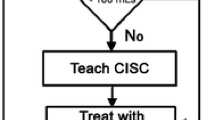Abstract
Urge urinary incontinence (UUI) is a chronic disorder affecting 12 million men and women in the United States alone, and is characterized by involuntary loss of urine associated with urgency. UUI may be associated with detrusor overactivity (DO), which is the occurrence of involuntary detrusor contractions during a urodynamics evaluation. When DO occurs in the setting of known neurologic disease, it is referred to as neurogenic DO. The presence of DO by urodynamics warrants neurological evaluation in patients without known neurologic disease when there is subjective or objective evidence of neurologic disease, or if there is a high index of suspicion for an occult neurologic disorder.
Similar content being viewed by others
References
Papers of particular interest, published recently, have been highlighted as: • Of importance •• Of major importance
Abrams P, Cardozo M, Fall M, et al. The standardization of terminology of lower urinary tract function: report from the standardization sub-committee of the international continence society. Neurourol Urodyn. 2002;21:167–78.
Herzog AR, Fultz NH. Prevalence and incidence of urinary incontinence in community-dwelling populations. J Am Geriatr Soc. 1990;38:273.
Stewart WR, Herzog R, Wein A. Prevalence and impact of OAB in the US: Results from the NOBLE program. Neurourol Urodyn. 2001;20:406–8.
•• Haylen BT, de Ridder D, Freeman RM, et al. An International Urogynecological Association (IUGA)/International Continence Society (ICS) Joint Report on the Terminology for Female Pelvic Floor Dysfunction. Neurourol Urodyn. 2010;29:4–20. This paper is vital to ensure consistent communication between practitioners who care for women with pelvic floor dysfunction.
Blaivas JG. The neurophysiology of micturition: a clinical study of 550 patients. J Urol. 1982;127:958–63.
Bradley WE, Timm GW, Scott FB. Innervation of the detrusor muscle and urethra. Urol Clin N Am. 1974;1:3–27.
• de Groat W, Yoshimura N. Changes in afferent activity after spinal cord injury. Neurourol Urodyn. 2010;29:63–76. This is an excellent review of bladder pathophysiology associated with spinal cord injury.
Kennelly MJ, DeVoe WB. Overactive bladder: pharmacologic treatments in the neurogenic population. Rev Urol. 2008;10:182–91.
Carlson KV, Rome S, Nitti VW. Dysfunctional voiding in women. J Urol. 2001;165:143–8.
Arikan N, Soygür T, Selçuki M, et al. Role of magnetic resonance imaging in children with voiding dysfunction: Retrospective analysis of 81 patients. Urology. 1999;54:157–60.
Sand P, Gandhi S. History and physical examination in pelvic floor disorders. In: Female urology, urogynecology, and voiding dysfunction. New York: Marcel Dekker; 2005: pp. 119–139.
Watanabe T, Rivas DA, Chancellor MB. Urodynamics of spinal cord injury. Urol Clin N Am. 1996;23:459–73.
Lazzeri M, Spinelli M. Afferents and lower urinary tract symptoms: pathophysiology and future afferent therapy. Curr Bladder Dysfunct Rep. 2008;3:217–23.
Blaivas JG, Fisher DM. Combined radiolographic and urodynamics monitoring: advances in techniques. J Urol. 1981;125:693–4.
Chartier-Kastler EJ, Mongiat-Artus P, Bitker MO, et al. Long-term results of augmentation cystoplasty in spinal cord injury patients. Spinal Cord. 2000;38(8):490–4.
Disclosure
Dr. Eilber has served as a consultant for the American Medical Systems; and has served on the speakers’ bureau for Astellas and Pfizer.
Dr. Wood reported no potential conflicts of interest relevant to this article.
Author information
Authors and Affiliations
Corresponding author
Rights and permissions
About this article
Cite this article
Wood, L.N., Eilber, K.S. Neurological Work-Up for Urge Urinary Incontinence: When and in Whom?. Curr Bladder Dysfunct Rep 7, 247–251 (2012). https://doi.org/10.1007/s11884-012-0148-5
Published:
Issue Date:
DOI: https://doi.org/10.1007/s11884-012-0148-5




